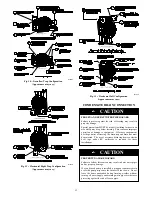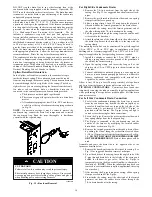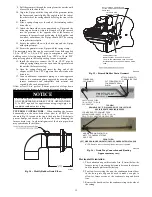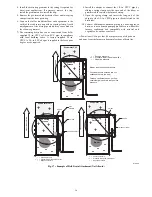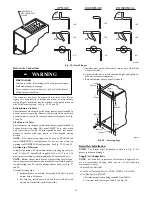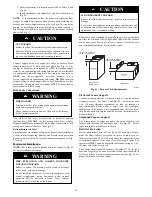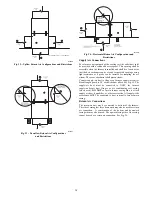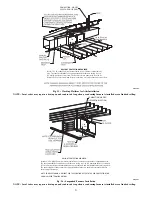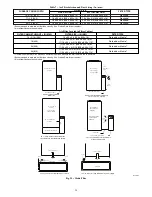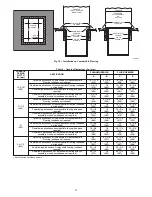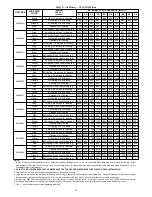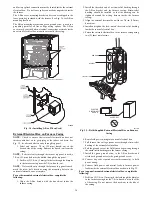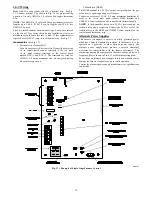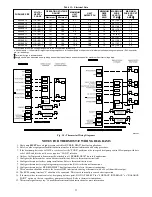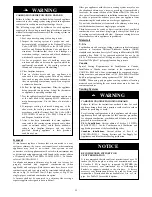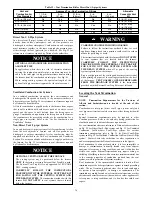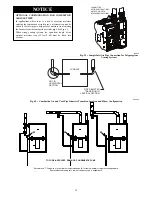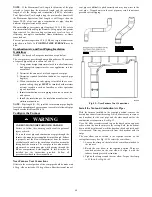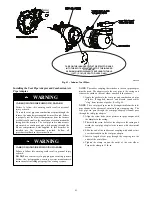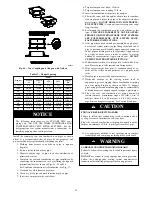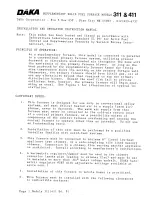
27
AIR DUCTS
Many states, provinces and localities are considering or have
implemented standards and/or restrictions on duct sizing
practices, ductwork leakage, and/or ductwork thermal, airflow
and electrical efficiencies. CONSULT LOCAL CODE
OFFICIALS
for
ductwork
design
and
performance
requirements in your area.
NOTICE
General Requirements
The duct system should be designed and sized according to
accepted national standards such as those published by: Air
Conditioning Contractors Association (ACCA Manual D), Sheet
Metal and Air Conditioning Contractors National Association
(SMACNA) or American Society of Heating, Refrigerating and
Air Conditioning Engineers (ASHRAE) or consult
The Air
Systems Design Guidelines
reference tables available from your
local distributor. The duct system should be sized to handle the
required system design CFM at the design external static pressure.
The furnace airflow rates are provided in Table 9--Air
Delivery--CFM (With Filter). When a furnace is installed so that
the supply ducts carry air circulated by the furnace to areas outside
the space containing the furnace, the return air shall also be
handled by duct(s) sealed to the furnace casing and terminating
outside the space containing the furnace.
Secure ductwork with proper fasteners for type of ductwork used.
Seal supply-- and return--duct connections to furnace with code
approved tape or duct sealer.
NOTE
: Flexible connections should be used between ductwork
and furnace to prevent transmission of vibration.
Ductwork passing through unconditioned space should be
insulated to enhance system performance. When air conditioning is
used, a vapor barrier is recommended.
Maintain a 1--in. (25 mm) clearance from combustible materials to
supply air ductwork for a distance of 36--in. (914 mm) horizontally
from the furnace. See NFPA 90B or local code for further
requirements.
Return Duct Sizing
Refer to the Filter Selection and Duct Sizing section for
information on the proper selection of filter sizes and the associated
ductwork and duct transitions. Improperly designed filtering
systems and return ductwork are the most common causes of
airflow and/or noise complaints in HVAC systems.
Ductwork Acoustical Treatment
NOTE
: Metal duct systems that do not have a 90 degree elbow
and 10 ft. (3 M) of main duct to the first branch take--off may
require internal acoustical lining. As an alternative, fibrous
ductwork may be used if constructed and installed in accordance
with the latest edition of SMACNA construction standard on
fibrous glass ducts. Both acoustical lining and fibrous ductwork
shall comply with NFPA 90B as tested by UL Standard 181 for
Class 1 Rigid air ducts.
NOTE
: For horizontal applications, the top most flange may be
bent past 90
_
to allow the evaporator coil to hang on the flange
temporarily while the remaining attachment and sealing of the coil
are performed.
GAS PIPING
FIRE OR EXPLOSION HAZARD
Failure to follow this warning could result in personal
injury, death, and/or property damage.
Never purge a gas line into a combustion chamber. Never
test for gas leaks with an open flame. Use a commercially
available soap solution made specifically for the detection
of leaks to check all connections. A fire or explosion may
result causing property damage, personal injury or loss of
life.
!
WARNING
FIRE OR EXPLOSION HAZARD
Failure to follow this warning could result in personal
injury, death, and/or property damage.
Use proper length of pipe to avoid stress on gas control
manifold and gas valve.
!
WARNING
FIRE OR EXPLOSION HAZARD
Failure to follow this warning could result in personal
injury, death, and/or property damage.
Gas valve inlet and/or inlet pipe must remain capped until
gas supply line is permanently installed to protect the valve
from moisture and debris. Also, install a sediment trap in the
gas supply piping at the inlet to the gas valve.
!
WARNING
Gas piping must be installed in accordance with national and local
codes. Refer to current edition of NFGC in the U.S.A. Refer to
current edition of NSCNGPIC in Canada.
Installations must be made in accordance with all authorities
having jurisdiction. If possible, the gas supply line should be a
separate line running directly from meter to furnace.
NOTE
: Use a back--up wrench on the inlet of the gas valve when
connecting the gas line to the gas valve.
In the state of Massachusetts:
1. Gas supply connections MUST be performed by a licensed
plumber or gas fitter.
2. When flexible connectors are used, the maximum length
shall not exceed 36 in. (915 mm).
3. When lever handle type manual equipment shutoff valves
are used, they shall be T--handle valves.
4. The use of copper tubing for gas piping is NOT approved
by the state of Massachusetts.
NOTICE
Refer to Table 10 for recommended gas pipe sizing. Risers must be
used to connect to furnace and to meter. Support all gas piping
with appropriate straps, hangers, etc. Use a minimum of one hanger
every 6 ft. (2 M). Joint compound (pipe dope) should be applied
Содержание 915SB
Страница 65: ...65 A190099 Fig 63 Service Label Information...
Страница 76: ...76 A190093 Fig 69 Troubleshooting Guide Cont...
Страница 77: ...77 344442 2 Rev C A190259 Fig 70 Wiring Diagram...

